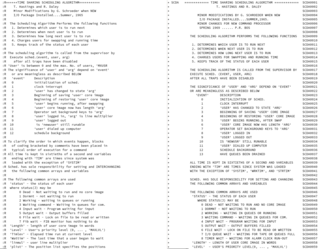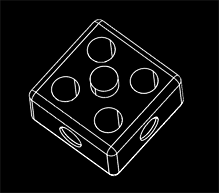Related Research Articles

Fortran is a general-purpose, compiled imperative programming language that is especially suited to numeric computation and scientific computing.
PL/I is a procedural, imperative computer programming language developed and published by IBM. It is designed for scientific, engineering, business and system programming. It has been used by academic, commercial and industrial organizations since it was introduced in the 1960s, and is still used.
MAD is a programming language and compiler for the IBM 704 and later the IBM 709, IBM 7090, IBM 7040, UNIVAC 1107, UNIVAC 1108, Philco 210-211, and eventually IBM System/370 mainframe computers. Developed in 1959 at the University of Michigan by Bernard Galler, Bruce Arden and Robert M. Graham, MAD is a variant of the ALGOL language. It was widely used to teach programming at colleges and universities during the 1960s and played a minor role in the development of Compatible Time-Sharing System (CTSS), Multics, and the Michigan Terminal System computer operating systems. The original version of the chatbot ELIZA was written in MAD-SLIP.
The GE-600 series was a family of 36-bit mainframe computers originating in the 1960s, built by General Electric (GE). When GE left the mainframe business the line was sold to Honeywell, which built similar systems into the 1990s as the division moved to Groupe Bull and then NEC.

The IBM 704 is a large digital mainframe computer introduced by IBM in 1954. It was the first mass-produced computer with hardware for floating-point arithmetic. The IBM 704 Manual of operation states:
The type 704 Electronic Data-Processing Machine is a large-scale, high-speed electronic calculator controlled by an internally stored program of the single address type.

The IBM 7090 is a second-generation transistorized version of the earlier IBM 709 vacuum tube mainframe computer that was designed for "large-scale scientific and technological applications". The 7090 is the fourth member of the IBM 700/7000 series scientific computers. The first 7090 installation was in December 1959. In 1960, a typical system sold for $2.9 million or could be rented for $63,500 a month.
General Comprehensive Operating System is a family of operating systems oriented toward the 36-bit GE/Honeywell mainframe computers.

The IBM 700/7000 series is a series of large-scale (mainframe) computer systems that were made by IBM through the 1950s and early 1960s. The series includes several different, incompatible processor architectures. The 700s use vacuum-tube logic and were made obsolete by the introduction of the transistorized 7000s. The 7000s, in turn, were eventually replaced with System/360, which was announced in 1964. However the 360/65, the first 360 powerful enough to replace 7000s, did not become available until November 1965. Early problems with OS/360 and the high cost of converting software kept many 7000s in service for years afterward.
This article presents a timeline of events in the history of computer operating systems from 1951 to the current day. For a narrative explaining the overall developments, see the History of operating systems.

The Compatible Time-Sharing System (CTSS) was the first general purpose time-sharing operating system. Compatible Time Sharing referred to time sharing which was compatible with batch processing; it could offer both time sharing and batch processing concurrently.
MUSIC-N refers to a family of computer music programs and programming languages descended from or influenced by MUSIC, a program written by Max Mathews in 1957 at Bell Labs. MUSIC was the first computer program for generating digital audio waveforms through direct synthesis. It was one of the first programs for making music on a digital computer, and was certainly the first program to gain wide acceptance in the music research community as viable for that task. The world's first computer-controlled music was generated in Australia by programmer Geoff Hill on the CSIRAC computer which was designed and built by Trevor Pearcey and Maston Beard. However, CSIRAC produced sound by sending raw pulses to the speaker, it did not produce standard digital audio with PCM samples, like the MUSIC-series of programs.

In 3D computer graphics, solid objects are usually modeled by polyhedra. A face of a polyhedron is a planar polygon bounded by straight line segments, called edges. Curved surfaces are usually approximated by a polygon mesh. Computer programs for line drawings of opaque objects must be able to decide which edges or which parts of the edges are hidden by an object itself or by other objects, so that those edges can be clipped during rendering. This problem is known as hidden-line removal.

Space Travel is an early video game developed by Ken Thompson in 1969 that simulates travel in the Solar System. The player flies their ship around a two-dimensional scale model of the Solar System with no objectives other than to attempt to land on various planets and moons. The player can move and turn the ship, and adjust the overall speed by adjusting the scale of the simulation. The ship is affected by the single strongest gravitational pull of the astronomical bodies.

IBSYS is the discontinued tape-based operating system that IBM supplied with its IBM 709, IBM 7090 and IBM 7094 computers. A similar operating system, also called IBSYS, was provided with IBM 7040 and IBM 7044 computers. IBSYS was based on FORTRAN Monitor System (FMS) and Bell Labs' "BESYS" rather than the SHARE Operating System. IBSYS directly supported several old language processors on the $EXECUTE card: 9PAC, FORTRAN and IBSFAP. Newer language processors ran under IBJOB.
ALTRAN is a programming language for the formal manipulation of rational functions of several variables with integer coefficients. It was developed at Bell Labs in 1960s. ALTRAN is a FORTRAN version of ALPAK rational algebra package, and “can be thought of as a variant of FORTRAN with the addition of an extra declaration, the ‘algebraic’ type declaration.”
Digitek was an early system software company located in Los Angeles, California.
BEFLIX is the name of the first embedded domain-specific language for computer animation, invented by Ken Knowlton at Bell Labs in 1963. The name derives from a combination of Bell Flicks. Ken Knowlton used BEFLIX to create animated films for educational and engineering purposes. He also collaborated with the artist Stan Vanderbeek at Bell Labs to create a series of computer-animated films called Poemfields between 1966 and 1969.
BESYS was an early computing environment originally implemented as a batch processing operating system in 1957 at Bell Labs for the IBM 704 computer.
DAC-1, for Design Augmented by Computer, was one of the earliest graphical computer aided design systems. Developed by General Motors, IBM was brought in as a partner in 1960 and the two developed the system and released it to production in 1963. It was publicly unveiled at the Fall Joint Computer Conference in Detroit 1964. GM used the DAC system, continually modified, into the 1970s when it was succeeded by CADANCE.
References
- ↑ Rickles, Dean; Blum, Alexander (October 6, 2015). "Paul Weiss and the genesis of canonical quantization". European Physical Journal H. 40 (4–5): 469–487. Bibcode:2015EPJH...40..469R. doi:10.1140/epjh/e2015-60001-5.
- ↑ Birth Registration, Willesden, Middlesex, England; General Register Office, Southport, England; Line 113, Vol. 3A
- 1 2 Immigration, New York City, New York, United States, NARA microfilm publication T715 (Washington, D.C.: National Archives and Records Administration, n.d.)
- ↑ Ruth Elizabeth Weiss, Naturalization Petition and Record, U.S. District Court, Eastern District of Michigan, Southern Division, Detroit, Certificate No. 8637552, Issued April 28, 1964
- ↑ Holbrook, Bernard D.; Brown, W. Stanley. "Computing Science Technical Report No. 99 – A History of Computing Research at Bell Laboratories (1937–1975)". Bell Labs. Archived from the original on September 2, 2014. Retrieved September 2, 2014.
- ↑ Bell L2 Interpreter at the Wayback Machine (archived July 21, 2005)
- ↑ Kaisler, Stephen (2017). Birthing the Computer: from drums to cores. Cambridge Scholars Publishing. p. 20. ISBN 1443885118.
- ↑ "Multics System Programmer's Manual". Archived from the original on March 28, 2006. Retrieved September 2, 2020.
- 1 2 Ruth A. Weiss BE VISION, A Package of IBM 7090 FORTRAN Programs to Draw Orthographic Views of Combinations of Plane and Quadric Surfaces
- ↑ Wayne E. Carlson Computer Graphics and Computer Animation: A Retrospective Overview
- ↑ I. E. Sutherland. Ten unsolved problems in computer graphics. Datamation, 12(5):22–27, 1966.
- ↑ Ruth A. Weiss. Letters. Datamation, 12(8):12, 1966.